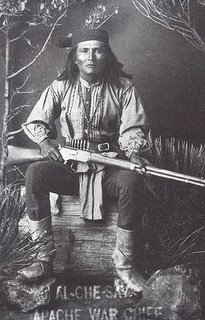Museum.

This is coolbert:
The other day was a significant day for the American Indian. A museum of American Indian artifacts devoted to displaying American Indian culture in all it's forms was opened.
And the museum is state-of-the-art and the museum building itself appears to be a major work of architecture. Modern, innovative, and state-of-the-art displays on the inside.
And many persons are commenting on how overdue such a museum is.
Most of the displays are from artifacts that were in safekeeping in either the Smithsonian Museum or held by the Bureau of Indian Affairs [BIA]. And a lot of input into how to display the artifacts was forthcoming from American Indians themselves.
After all, this museum is dedicated to them. And this input was apparently judiciously displayed. The museum is generally accepted as being a very significant accomplishment.
Some artifacts, however, for some reason, are not on display.
These artifacts that have omitted, for whatever reason, are implements of WAR.
For some reason, the persons that decided as to what artifacts are to be displayed, did not deem implements of war as worthy of display. [only about 10 % of the artifacts that can be displayed are actually on display at any one given time].
There is presumably a wide variety of war artifacts that could be placed on display. This would include the usual suspects of knives, lances, clubs, tomahawks, and bow and arrow [The latter evidently was used sparingly by American Indians when in combat among themselves. American Indians, when fighting one another, seem to have preferred close quarters, hand-hand combat over the use of long-range missile fire as represented by bow and arrow].
Undoubtedly there are ulterior motives for not including war implements among the items on display in the museum. The curators do NOT want to display the American Indian as being aggressive and warlike. Rather, they want to portray the American Indian as being happy, contented hunter-gatherers and marginal agriculturalists living in harmony with nature and at peace among themselves. NOT as tribes and societies that had a warlike side to them.
This message is both correct and incorrect.
There were American Indian tribes that did live very peaceful and relatively contented lives, war being NOT an element of their culture.
And then there were other American Indian tribes that seem to have been thoroughly immersed in warfare.
Among the latter tribes, those that waged war on a almost continuous basis [and very successfully too], were the Apache, Sioux, and the Iroquois.
All three tribes were aggressive, warlike, and predatory.
All three tribes were highly skilled at war making and torture, and greatly feared by their neighbors.
All three tribes were expansionist, moving from their "homelands" to invade, conquer, and expel their neighbors. [Apache from Canada moved south following the Rocky Mountains to the area around New Mexico, Arizona, and northern Mexico. Sioux moved from the north woods of Minnesota to the area of the Great Plains. Iroquois moved from the Great Lakes eastward into the lakes area of upstate New York.]
All three tribes gave great resistance to the American settlers, those settlers intent upon their own expansion. On a number of occasions, these three tribes did inflict significant military defeats upon the settlers.
The very names Apache and Sioux means "enemy" in the language of their foes. The Sioux were also referred to by their enemies as "the tribe that will not listen!". Among themselves, the Apache like to call themselves Dine [din-eh] and the Sioux refer to themselves as Lakota.
These tribes did have a societal structure that was conducive to war making.
The Confederation of the Iroquois was efficient and well developed. At one point the Iroquois themselves suggested to the American colonialists that the Iroquois structure of government would make an excellent model for the colonialists to follow and emulate.
Joseph Campbell relates how American Indians organized their warriors into "societies". Societal organization that had a rational basis for waging war. Such as:
"Little Birds: Boys from 15 to 20 years old.
Pigeons: Men who have been to war several times.
Mosquitoes: Men who are constantly going to war.
Braves: Tried warriors.
All Crazy Dogs: Men about 40 years old.
Raven Bearers: [not described].
Dogs; Tails: Old men.
Horns; Bloods: Societies with peculiar secret ceremonies.
Soldiers: [not described].
Bulls: A society wearing the bull's heads and robes [buffalo??]."
It is not correct to NOT include implements of war in the exhibits at the American Indian museum. War, warmaking, conquest, etc., is all a part of American Indian culture and history just as it is for cultures found anywhere in the world. To neglect this part of the culture is NOT appropriate. Do not dwell upon it, but include it. Maybe future curators will??
coolbert.

0 Comments:
Post a Comment
Subscribe to Post Comments [Atom]
<< Home